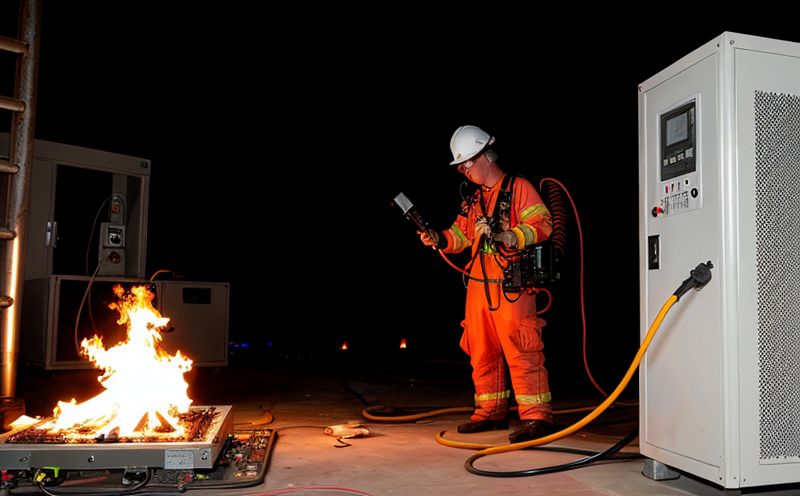Toxic Gas Emission Analysis of Burning Electrical Components
The analysis and quantification of toxic gases emitted during the burning of electrical components is a critical aspect of fire safety testing. This service ensures that electronic devices meet stringent regulatory requirements, protect public health, and ensure workplace safety. Toxic gas emissions can have severe consequences if not properly controlled, especially in environments where people are present or in close proximity to potential ignition sources.
Our laboratory adheres to international standards such as ISO 13630:2019 and ASTM E678-18, which provide guidelines for the testing of materials used in electrical equipment. These standards ensure that the test methods are consistent and reliable across different laboratories.
The process begins with careful selection and preparation of the electrical components to be tested. The specimens must be representative of real-world usage conditions and should reflect the worst-case scenario regarding potential fire risks. Once prepared, the samples undergo rigorous testing in our state-of-the-art facilities using advanced instrumentation like gas analyzers and thermogravimetric analysis (TGA) systems.
The test setup involves placing the electrical components within a controlled combustion chamber where they are subjected to specific heating profiles that simulate real-world burning conditions. The temperature, time, and airflow parameters are carefully calibrated to mimic the environment in which these components may operate under fire hazard scenarios. This ensures accurate measurement of the gases released during combustion.
The emitted gases are then captured and analyzed using sophisticated analytical equipment capable of detecting even trace amounts of hazardous compounds such as carbon monoxide (CO), nitrogen oxides (NOx), hydrogen cyanide (HCN), and others specified by relevant standards. The data collected is meticulously recorded, providing a comprehensive profile of the toxic emissions.
Our team of experienced engineers interprets these results to provide detailed reports that not only comply with regulatory requirements but also offer valuable insights into how design changes or material substitutions could mitigate risks associated with toxic gas release during fires. These findings are crucial for manufacturers, ensuring they can continue producing safe and compliant products.
The importance of this service extends beyond mere compliance; it plays a pivotal role in safeguarding lives and property by identifying potential hazards early enough to implement corrective measures. By adhering strictly to internationally recognized standards like ISO 13630:2019, ASTM E678-18, and EN 50262, we ensure our clients receive accurate, reliable data that supports informed decision-making processes within their organizations.
Applied Standards
| Standard | Description |
|---|---|
| ISO 13630:2019 | International standard providing guidelines for the testing of materials used in electrical equipment. |
| ASTM E678-18 | American Society for Testing and Materials guideline for the evaluation of thermal stability and decomposition products from polymeric materials. |
| EN 50262 | European standard addressing electromagnetic compatibility (EMC). |
Customer Impact and Satisfaction
- Ensures compliance with international safety regulations.
- Reduces risks associated with toxic gas emissions in industrial settings.
- Provides valuable data for continuous improvement of product designs.
- Supports informed decision-making processes within organizations.
Use Cases and Application Examples
This service has wide-ranging applications across various industries, including electronics manufacturing, construction, automotive, and consumer goods. For instance, in the case of a smartphone manufacturer, understanding the toxic gas emissions from its battery cells can help identify areas for improvement that enhance safety without compromising performance.
In another example, during the design phase of new residential buildings, architects might use this service to assess the impact of different types of wiring and insulation materials on indoor air quality. By doing so, they ensure compliance with local building codes while also promoting healthier living environments for occupants.





